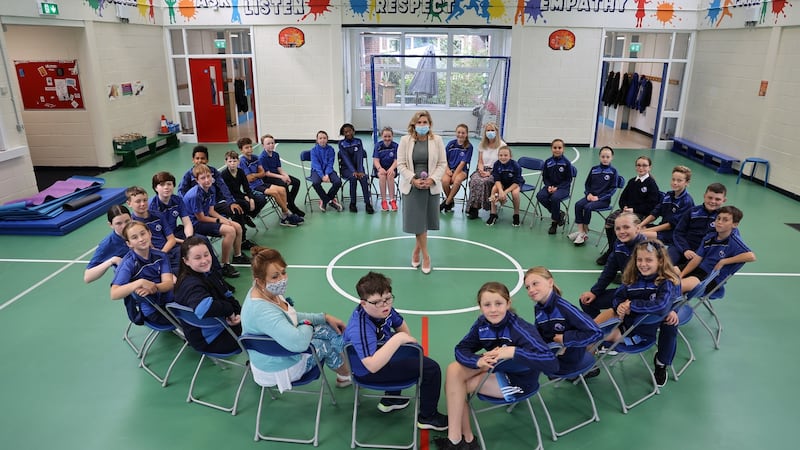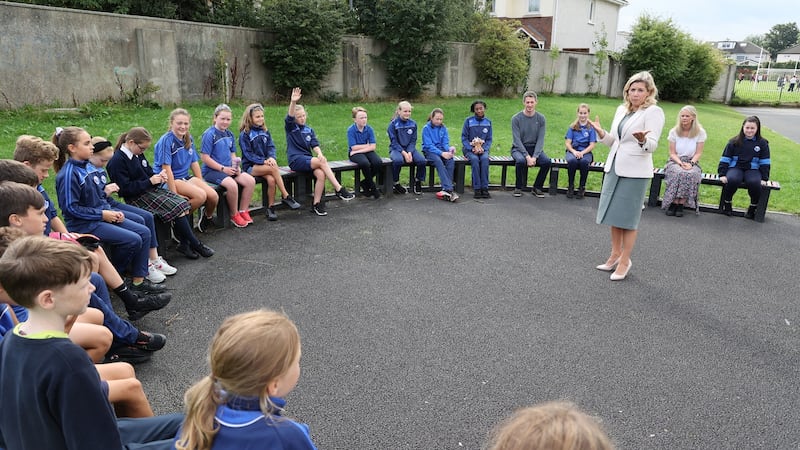“The boys in my class got into a lot of trouble today,” my nine-year-old daughter’s neighbourhood friend confides, jumping up and down on the kerb, brandishing a lop-sided ice-cream. “They had to stand up against the wall at lunchtime.”
Her eyes widen, relishing the playground drama.
As a teacher, I’m closer to uneasy than entertained. I’m also grateful for my training in restorative practice, or RP for short. I’m grateful to work in one of the many Irish schools where such punishments are deemed unacceptable.
Restorative practice looks beyond traditional sanctions. It seeks to restore the damage done by poor behaviour through conversation and reflection. The focus is not on the behaviour but the individual.
Instead of relying on detentions and suspensions, teachers ask young people to talk, reflect, dig deeper. Traditional sanctions can still exist but as the culture becomes more restorative, the demand for such sanctions lessens.
This focus on the student is reiterated by Dr Kathryn Corbett, principal of Bishop Galvin National School in Templeogue, Dublin. For her, distance learning during Covid really brought to the fore the scope of what schools do and the importance of the approach.
“As a community it’s so much more than just subjects,” she says. “Relationships are central to learning, both teacher to pupil, and among peer groups. It was so evident in engagement online. RP has become even more relevant for our recovery as a community.”
There’s a refreshing blend of optimism and realism in her school’s approach. Their code of behaviour also recognises “factors in and outside school that may affect behaviour, and that that behaviour can change with the right support and intervention”.
Dr Corbett says: “We looked at our original code of behaviour and realised it didn’t match what we were doing in the school, which involved really listening to children, empathising with them.

“We began by replacing words like ‘rule’ with ‘expectation’, and ‘warning’ with ‘reminder’. Now RP informs everything we do. It was so important during lockdown because it reminded us to stay focused on connection, on relationships.”
She says students now have the language to express themselves and they are taking responsibility. “They recognise that behaviour is a big part of learning,” she says. “I remember going down the corridor with students years ago. They kept talking about being in trouble. RP shifts the focus back to the child and away from the sanction, away from a culture of blame.”
Dr Corbett alludes to the adoption of RP as a “journey” and is keen to point out the importance of involving parents throughout.
“We know that parents had very different school experiences. In the heat of a conflict, it’s hard to understand RP, so we inform parents beforehand, give parents the RP questions at parent teacher meetings. This kind of culture change is slow but it’s also very empowering for everyone,” she says.
Origins
In Ireland restorative practice has its modern roots in the Irish criminal justice system. Under the Children Act, 2001 and as part of the Garda Diversion Programme, juvenile liaison officers were trained in restorative practices and facilitation of restorative conferences/cautions.
Far deeper roots connect the approach to indigenous, tribal communities around the world and to Brehon law.
A recent report on restorative practice in Irish schools begins with a description of ubuntu, a practice associated with a region of South Africa in which a wrongdoer is reminded of their good qualities when they do harm. For two days, they're enclosed in a circle of tribespeople and brought back to their better selves.
Kieran O'Dwyer is a core member of Restorative Justice Strategies for Change (RJS4C), a group that aims to support the development of restorative justice in Europe. He first encountered restorative justice more than 20 years ago when he was tasked with evaluating the diversion programme being run by juvenile liaison officers. He felt transformed by the process and went on to write a PhD on its impact. He now trains teachers and others in the practice.
“I went into it as a cynic,” he says. “How could a 45-minute conversation change someone? But I was wrong.”

Offenders, he says, are often told to go to court and keep their mouths shut.
“They pay a debt in one way, but they never have to face up to what they’ve done. In some ways it’s made easy for them,” he says.
“To sit down with someone you’ve hurt… it’s really powerful, and much more difficult overall.”
O’Dwyer is quick to point out that the process isn’t a “golden bullet” and that change in culture takes time. “You have to be really careful with it. It’s entirely voluntary and a lot of victims don’t want anything to do with their perpetrators.
“Sometimes the session won’t go the way you hope, but often people will go away and think about it. You’ll hit their rethink button.”
He remembers one youngster, in particular, who had broken into a woman’s home but he hadn’t thought about anything other than meeting his own needs.
“People are impulsive. But asking him to reflect on his actions, to look at his victim, allowed him to tap into his own humanity,” he says.
There is hard data to show the impact of this approach in schools. A study published in 2013 by the University of Ulster – involving 14 second-level schools, five youth reach centres and two youth organisations in Co Donegal – shows dramatic results in the use of restorative practice in working with young people.
Over the course of a year, instances of disruptive behaviour fell from 176 to 31. Challenges to teacher authority dropped from 99 to 12. Suspensions decreased by 25 per cent.
National and international bodies are keen for more teachers to adopt these approaches, given that the link between traditional school sanctions and life struggles is well documented.
Dr Paul Downes, associate professor of psychology in DCU's Institute of Education, found last year that one in four homeless men in McVerry Trust Accommodation reported being temporarily excluded in the form of suspensions; more than a third of these were due to difficult relationships with teachers.
Tellingly, most survey respondents indicated that they had experienced “traumatic childhood events”. Such students are 10 times more likely to leave school early and are more likely to land in the juvenile justice system.
“Ireland is radically out of step with many European countries who provide emotional counselling/therapeutic services in schools,” Dr Downes said.
“This is not addressed by National Educational Psychological Service or career guidance as neither provide or are suitable to provide ongoing individual therapeutic supports for trauma and complex emotional needs.”
In this kind of context, the practice of lining children up against the wall seems sorely lacking.
Conflict resolution: How you can use restorative practice:
Restorative practice, which prioritises conflict resolution over punishment, is becoming more common in training for primary and second-level teachers. It is being rolled out to schools via the Professional Development Service for Teachers. Some of the basic questions used in restorative practice include: – What happened? – What were you thinking of at the time? – What have you thought about it since? – Who has been affected and in what way? – How could things have been done differently? – What do you think needs to happen next?









